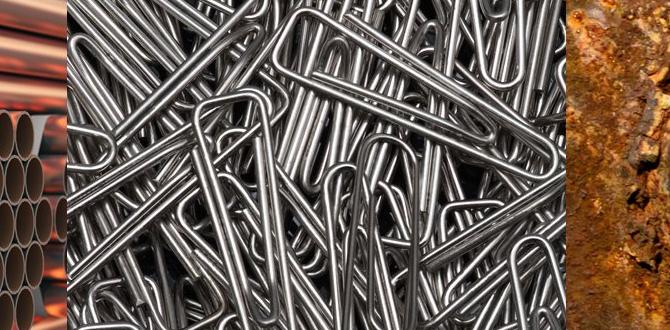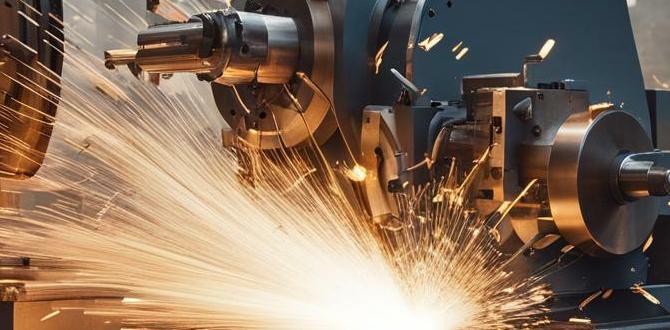Carbide end mills are a game-changer for machining hardened steel up to HRC60, offering superior performance and longevity for precise cuts, especially with MQL setups.
Machining hardened steel can feel like wrestling a bear – tough, frustrating, and often resulting in dull tools or damaged workpieces. Many beginners dread this task, but what if there was a tool specifically designed to make it simpler and more effective? Enter the carbide end mill. These aren’t your everyday cutters; they’re precision-engineered powerhouses. If you’ve ever stared at a block of hardened steel and wondered how to shape it without breaking your tools, you’re in the right place. We’re going to explore why carbide end mills are the genius solution you’ve been looking for, making even tough materials a breeze to work with. Get ready to transform your machining experience!
Why is Machining Hardened Steel So Tricky?
Hardened steel, especially materials hardened to Rockwell C (HRC) ratings of 50-60 or more, presents a significant challenge for most cutting tools. This hardness is achieved through heat treatment, which makes the steel incredibly strong and durable, perfect for applications requiring wear resistance and toughness. However, this very strength makes it difficult to cut.
Traditional High-Speed Steel (HSS) tools often struggle. They can overheat quickly, leading to rapid dulling and potential tool breakage. The immense forces required to cut hardened steel can also put a strain on your milling machine and the workpiece itself, leading to chatter and poor surface finishes. This is where specialized tooling becomes not just beneficial, but essential.
Introducing the Carbide End Mill: Your Hardened Steel Hero
Carbide, specifically Tungsten Carbide, is a composite material formed by bonding tungsten carbide with a binder, usually cobalt. This combination creates an incredibly hard and rigid substance, much harder and stiffer than HSS. This inherent hardness is what makes carbide end mills exceptionally well-suited for machining tough materials like hardened steel.
When we talk about a “carbide end mill for hardened steel,” we’re usually referring to end mills made from specific grades of carbide with geometries optimized for this demanding task. These end mills are designed to:
- Withstand higher cutting temperatures.
- Maintain their cutting edge longer.
- Cut harder materials without excessive wear.
- Provide a better surface finish and dimensional accuracy.
Key Advantages of Using Carbide End Mills for Steel
The benefits of choosing a carbide end mill for your hardened steel projects are substantial:
- Superior Hardness: Carbide is significantly harder than HSS, allowing it to cut through materials that would quickly dull or destroy conventional bits. This means you can successfully machine metals hardened to HRC 60 and beyond.
- Heat Resistance: Machining generates heat. Carbide can tolerate much higher temperatures than HSS before softening, which is crucial when cutting hard materials where friction is high. This allows for faster cutting speeds and deeper cuts.
- Rigidity: The stiffness of carbide leads to less tool deflection. This means more accurate parts and less risk of chatter, resulting in cleaner cuts and a better surface finish.
- Longer Tool Life: While more expensive upfront, carbide end mills typically last much longer than HSS tools when used correctly on appropriate materials. This translates to lower costs per part over time and less frequent tool changes.
- Increased Productivity: The ability to cut faster and deeper with carbide means you can complete your machining jobs in less time, boosting your overall workshop productivity.
Understanding the “Genius” in “Carbide End Mill: Genius For Hardened Steel”
The “genius” aspect comes from how these end mills are specifically engineered to overcome the limitations of machining hardened steel. It’s not just about the material; it’s about the design and application.
Consider a specific example: a “Carbide end mill 1/4 inch 1/4 shank stub length for hardened steel hrc60 MQL friendly.” Let’s break down what makes this combination so effective:
- Carbide Material: As discussed, this is the core of its capability.
- 1/4 Inch Diameter: A versatile size for many hobbyist and professional tasks. It allows for fine detail work and can be used in a wide range of milling machines.
- 1/4 Inch Shank: This standard shank size ensures compatibility with most collets and tool holders for common milling machines.
-
Stub Length: This is a critical feature. Stub length end mills have a shorter flute length and overall length compared to standard or extra-long versions.
- Reduced Deflection: With less overhang, there’s less opportunity for the tool to flex under cutting forces. This rigidity is vital when cutting hard, resistant materials, leading to straighter slots and more accurate profiles.
- Increased Strength: The shorter tool body is inherently stronger and less prone to breakage.
- Higher Feed Rates: The rigidity can sometimes allow for more aggressive feed rates, further increasing productivity.
- For Hardened Steel HRC60: This specification tells you the end mill is designed and manufactured to effectively machine steels hardened up to HRC 60. This is a common range for many hardened tool steels and wear-resistant alloys.
-
MQL Friendly: MQL stands for Minimum Quantity Lubrication. This system uses a very small amount of high-pressure coolant (often an oil-based mist) directed precisely at the cutting zone.
- Benefits of MQL:
- Improved Cooling: Even though carbide handles heat well, effective cooling is still crucial for tool life and part surface finish by preventing thermal expansion and chipping.
- Enhanced Lubrication: Reduces friction between the cutting edge and the workpiece, leading to smoother cutting and better chip evacuation.
- Chip Evacuation: The mist can help blow chips away from the cutting area, preventing re-cutting and tool damage.
- Cleaner Work Area: Significantly reduces the mess associated with traditional flood coolants.
- Why “MQL Friendly” Matters: An end mill designed for MQL might have specific flute designs to work with the mist, ensuring it reaches the cutting edge effectively and helps clear chips.
- Benefits of MQL:
Choosing the Right Carbide End Mill for Hardened Steel
Not all carbide end mills are created equal, especially when targeting hardened steel. Here’s what to look for:
End Mill Types and Coatings
For hardened steel, you’ll typically want to look at:
- Solid Carbide End Mills: These are the standard for high-performance cutting. Their entire body is made of carbide.
-
Coatings: While bare carbide is hard, coatings can further enhance performance.
- AlTiN (Aluminum Titanium Nitride): Excellent for high-temperature applications, making it a top choice for hardened steels. It forms a protective aluminum oxide layer at high temperatures.
- TiCN (Titanium Carbonitride): Offers good wear resistance and lubricity, suitable for a wide range of steels.
- ZrN (Zirconium Nitride): Provides good lubricity and excellent oxidation resistance, performing well in stainless steels and titanium but also a good option for tougher steels.
Geometry Matters
The design of the flutes and cutting edges is critical:
-
Number of Flutes:
- 2 Flutes: Generally preferred for milling aluminum and plastics due to better chip clearance. However, they can also be used for steel, especially when slotting where chip evacuation is paramount.
- 3 Flutes: A good compromise for steel. Offers better rigidity and chip load capacity than 2 flutes, with reasonable chip evacuation.
- 4+ Flutes: Offer the best rigidity and surface finish. They are ideal for finishing passes and materials where chip evacuation isn’t a major concern. For hardened steel, 3 or 4 flutes are often the sweet spot.
- Helix Angle: A higher helix angle (e.g., 30-45 degrees) helps with chip evacuation and reducing cutting forces, making it good for steels. Some specialized end mills for hardened steel might have variable helix angles to break up harmonics and reduce chatter.
- Corner Radius/Chamfer: A small corner radius or a chamfer on the cutting edge adds strength and reduces the risk of chipping compared to a sharp, square corner. For very hard materials, a small radius is generally advisable.
Technical Specifications to Watch For
When you’re browsing for an end mill, you’ll see specific terms. Here’s a quick guide:
| Specification | Meaning | Importance for Hardened Steel |
|---|---|---|
| Material | Solid Carbide (often specific grades like YG-10N or equivalent) | Essential due to hardness and heat resistance. |
| Hardness Rating | Target material hardness (e.g., HRC 50-60) | Ensures the end mill is designed for the specific material toughness. |
| Coating | e.g., AlTiN, TiCN, ZrN | Improves tool life, heat resistance, and lubricity. AlTiN is often preferred for high-temp steels. |
| Number of Flutes | 2, 3, 4, etc. | 3 or 4 flutes offer a good balance of chip evacuation and rigidity for steels. |
| Helix Angle | Standard (30°), High (45°), Variable | Higher helix aids chip evacuation. Variable helix reduces chatter. |
| Shank Diameter | e.g., 1/4″, 1/2″ | Must match your machine’s collets/holders. |
| Flute Length/Overall Length | Standard, Stub, Extra-Long | Stub length is critical for rigidity when machining hard materials. |
| End Type | Square, Ball, Corner Radius | Square ends for slots, ball for contours, corner radius for strength. |
Setting Up Your Machine for Success
Simply having the right end mill isn’t enough. Proper machine setup and parameters are crucial for safely and effectively machining hardened steel.
Machine Requirements
Your milling machine should be:
- Rigid: A machine with play in the ways or spindle will fight against the forces, leading to chatter and poor results. Small hobby machines might struggle with harder steels, even with ideal tooling.
- Accurate: A well-calibrated machine ensures you can achieve precise dimensions.
- Spindle Speed and Feed Control: You need reliable control over RPMs and the ability to set consistent feed rates.
Coolant and Lubrication
While MQL is stated as a feature, if you don’t have an MQL system, consider alternatives:
- Flood Coolant: A traditional coolant system is very effective. Ensure the coolant is designed for ferrous metals.
- Mist Coolant: A less sophisticated mist system can also help.
- Air Blast: A strong blast of compressed air can assist chip evacuation and cooling, though it’s less effective than liquid coolants.
For MQL-friendly end mills, the system is designed to deliver a fine oil mist directly to the cutting edge. This is highly efficient for cooling and lubricating without using large volumes of fluid. You can learn more about effective metalworking fluids at resources like the Safety and Health Magazine, which often discusses best practices and safety around these substances.
Workholding
Securely holding your workpiece is non-negotiable. Use:
- Robust vises or clamps.
- Ensure the workpiece is seated firmly and won’t shift during cutting.
- Consider supports or stabilizers for larger or thinner parts.
Feeds and Speeds: The Golden Rules
This is where many beginners get tripped up. Machining hardened steel requires different parameters than softer materials. The exact feeds and speeds depend on the specific steel, the end mill’s diameter and flute count, the machine’s rigidity, and the coolant used. However, here are general guidelines:
General Guidelines for Carbide End Mills in Hardened Steel (HRC 50-60)
These are starting points. Always check the end mill manufacturer’s recommendations first.
| Parameter | Recommendation for 1/4″ Carbide End Mill | Notes |
|---|---|---|
| Cutting Speed (SFM) | Around 50-150 SFM (Surface Feet per Minute) | Start low and increase if possible. Lower for tougher steels, higher for less extreme hardness. |
| Spindle RPM | Calculate: RPM = (SFM × 3.82) / Diameter (inches) | For 1/4″ (0.25″) at 100 SFM: RPM = (100 3.82) / 0.25 = 1528 RPM. Expect RPMs typically between 500-2500 for a 1/4″ end mill depending on SFM. |
| Chip Load (IPM per tooth) | Around 0.0005″ – 0.0015″ | This is crucial. Too low = rubbing and heat; too high = chipping/breakage. Start on the lower end for hardened steel. |
| Feed Rate (IPM) | Calculate: IPM = RPM × Chip Load × Number of Flutes | For RPM 1500, 3 flutes, 0.0008″ chip load: IPM = 1500 0.0008 * 3 = 3.6 IPM. This will be very slow! Modern high-performance mills might go faster. |
| Depth of Cut (Axial) | 1-2 times the diameter is often too much for hardened steel. | Start with 0.020″ – 0.050″ (or ~10-20% of diameter) for roughing. |
| Width of Cut (Radial) | For slots: 50-100% of diameter. For profiling: 10-25% of diameter. | Lighter radial cuts reduce force and heat. |
Important Note: These are starting points. Always refer to the manufacturer’s catalog for recommended parameters for their specific end mill. Many manufacturers provide excellent, detailed charts. Always listen to your machine – odd noises, excessive vibration, or a poor chip formation are signs to back off.
For more in-depth guidance on machining parameters, resources like the Sandvik Coromant Machining Guides offer a wealth of technical information often used by professionals.
Step-by-Step: Milling Hardened Steel with a Carbide End Mill
Let’s walk through a typical operation, like milling a slot. This assumes you have a basic understanding of your milling machine’s operation.
1. Preparation is Key
- Inspect the End Mill: Ensure it’s sharp, free of damage, and has the correct coating for the job.
- Secure the Workpiece: Mount your hardened steel block firmly in your milling vise. Ensure it’s indicated so it’s perfectly square to the machine’s axes if needed.
- Set Up Coolant: If using MQL, ensure the nozzle is positioned correctly to spray the cutting zone. If using flood, turn it on.
- Install the End Mill: Securely insert the 1/4″ shank end mill into a clean collet and tighten it in your machine’s spindle. Ensure it’s runout-free.
2. Set Tool Length (Z-Zero)
- Bring the end mill down carefully until it just touches the top surface of your workpiece.
- Use a piece of paper or







